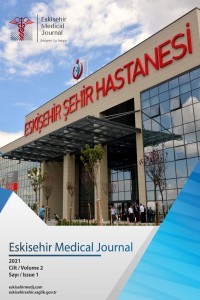COVID-19 Tanılı Hastalarda Koenfeksiyonlar ve Antimikrobiyal Direnç
SARS-CoV-2, koenfeksi̇yon, COVID-19
Co-infections and Antimicrobial Resistance in Patients Diagnosed with COVID-19
SARS-CoV-2, koenfeksi̇yon, COVID-19,
___
- 1. Bhimraj A, Morgan RL, Shumaker AH, et al. Infectious Diseases Society of America Guidelines on the Treatment and Management of Patients With Coronavirus Disease 2019 (COVID-19). Clin Infect Dis 2020;ciaa478. doi: 10.1093/cid/ciaa478.
- 2. Sharifipour E, Shams S, Esmkhani M, et al. Evaluation of bacterial co-infections of the respiratory tract in COVID-19 patients admitted to ICU. BMC Infect Dis 2020;20:1-7.
- 3. Mirzaei R, Goodarzi P, Asadi M, Soltani A, et al. Bacterial co-infections with SARS-CoV-2. IUBMB Life 2020;72:2097-111.
- 4. Dyar OJ, Huttner B, Schouten J, Pulcini C. What is antimicrobial stewardship? Clin Microbiol Infect 2017;23:793-8.
- 5. Wu CP, Adhi F, Highland K. Recognition and management of respiratory coinfection and secondary bacterial pneumonia in patients with COVID-19. Cleve Clin J Med 2020;87:659-63.
- 6. Zhou P, Liu Z, Chen Y, Xiao Y, Huang X, Fan XG. Bacterial and fungal infections in COVID-19 patients: A matter of concern. Infect Control Hosp Epidemiol 2020;41:1124-5.
- 7. Zhu N, Zhang D, Wang W, et al. A Novel Coronavirus from Patients with Pneumonia in China, 2019. N Engl J Med 2020;382:727-33.
- 8. Sopirala MM. Predisposition of COVID-19 patients to secondary infections. Curr Opin Infect Dis 2021;34:357-64.
- 9. Nori P, Cowman K, Chen V, et al. Bacterial and fungal coinfections in COVID-19 patients hospitalized during the New York City pandemic surge. Infect Control Hosp Epidemiol 2021;42:84-8.
- 10. Rawson TM, Moore LSP, Zhu N, et al. Bacterial and Fungal Coinfection in Individuals with Coronavirus: A Rapid Review to Support COVID-19 Antimicrobial Prescribing. Clin Infect Dis 2020;71:2459-68.
- 11. Chong WH, Saha BK, Ananthakrishnan R, Chopra A. State of the art review of secondary pulmonary infections in patients with COVID-19 pneumonia. Infection 2021;49:591-605.
- 12. Lansbury L, Lim B, Baskaran V, Lim WS. Co-infections in people with COVID-19: a systematic review and meta-analysis. J Infect 2020;81:266-75.
- 13. Fu Y, Yang Q, Xu M, et al. Secondary Bacterial Infections in Critical Ill Patients With Coronavirus Disease 2019. Open Forum Infect Dis 2020;7:ofaa220. doi: 10.1093/ofid/ofaa220.
- 14. Hughes S, Troise O, Donaldson H, Mughal N, Moore LSP. Bacterial and fungal coinfection among hospitalized patients with COVID-19: a retrospective cohort study in a UK secondary-care setting. Clin Microbiol Infect 2020;26:1395-9.
- 15. Wang L, Amin AK, Khanna P, et al. An observational cohort study of bacterial co-infection and implications for empirical antibiotic therapy in patients presenting with COVID-19 to hospitals in North West London. J Antimicrob Chemother 2021;76:796-803.
- 16. Ramadan HKA, Mahmoud MA, Aburahma MZ, et al. Predictors of severity and co-infection resistance profile in COVID-19 patients: First report from upper Egypt. Infect Drug Resist 2020;13:3409-22.
- 17. Dizbay M, Tunccan OG, Sezer BE, Aktas F, Arman D. Nosocomial Burkholderia cepacia infections in a Turkish university hospital: a five-year surveillance. J Infect Dev Ctries 2009;3:273-7.
- 18. Chen N, Zhou M, Dong X, et al. Epidemiological and clinical characteristics of 99 cases of 2019 novel coronavirus pneumonia in Wuhan, China: a descriptive study. Lancet 2020;395:507-13.
- 19. Leitão JH, Sousa SA, Ferreira AS, Ramos CG, Silva IN, Moreira LM. Pathogenicity, virulence factors, and strategies to fight against Burkholderia cepacia complex pathogens and related species. Appl Microbiol Biotechnol 2010;87:31-40.
- 20. Clancy CJ, Nguyen H. Coronavirus Disease 2019, Superinfections, and Antimicrobial Development: What Can We Expect? Clin Infect Dis 2020;71:2736-43.
- 21. WHO. Clinical management of COVID-19: interim guidance, 27 May 2020. World Health Organization. 2020.
- 22. Hoque MN, Akter S, Mishu ID, et al. Microbial co-infections in COVID-19: Associated microbiota and underlying mechanisms of pathogenesis. Microb Pathog 2021;156:104941.
- 23. Chedid M, Waked R, Haddad E, Chetata N, Saliba G, Choucair J. Antibiotics in treatment of COVID-19 complications: a review of frequency, indications, and efficacy. J Infect Public Health 2021;14:570-6.
- 24. Mete B, Zerdali EY, Aygun G, ve ark. Change in species distribution and antifungal susceptibility of candidemias in an intensive care unit of a university hospital (10-year experience). Eur J Clin Microbiol Infect Dis 2021;40:325-33.
- 25. Baddley JW, Thompson GR, Chen SCA, et al. Coronavirus Disease 2019-Associated Invasive Fungal Infection. Open Forum Infect Dis 2021;8:1-11.
- 26. Lai CC, Yu WL. COVID-19 associated with pulmonary aspergillosis: A literature review. J Microbiol Immunol Infect 2021;54:46-53.
- 27. Shweihat Y, Perry J, Shah D. Isolated Candida infection of the lung. Respir Med Case Rep 2015;16:18-9.
- 28. Samonis G, Galanakis E, Ntaoukakis M, et al. Effects of carbapenems and their combination with amikacin on murine gut colonisation by Candida albicans. Mycoses 2013;56:105-9.
- ISSN: 2718-0948
- Yayın Aralığı: Yılda 3 Sayı
- Başlangıç: 2020
- Yayıncı: Eskişehir Şehir Hastanesi
Merve Deniz DEĞİRMENCİ, Hasan ÇALIŞKAN, Emel GÜNEŞ
ADÖLESANLARDA KORONAVİRÜS ANKSİYETE ÖLÇEĞİ’NİN GEÇERLİK VE GÜVENİRLİK ÇALIŞMASI
Deniz YİĞİT, Dilek ŞAYIK, Ayfer AÇIKGOZ, Fezan MUTLU
ÜROLOJİ EĞİTİMİNİN COVID-19 DÖNEMİNDEKİ DURUMU
Mehmet Erhan AYDIN, Arif KALKANLI, Coskun KAYA, Mustafa SUNGUR, Aykut AYKAÇ
Ayça KOCAAĞA, Halime KILIÇ, Sevgi GÜLEÇ
ULNAR ARTERDEN ÇIKAN PALMAR TİP BİLATERAL KALICI MEDYAN ARTER OLGUSU
Rasim HAMUTOĞLU, Mehmet YILDIRIM, Şükrü Turan PEŞTEMALCI, Ahmet ERTAŞ, Özge Irmak DOĞANCI
Melik DEMİR, Ömer Ferudun AKKUŞ, Gökay TAYLAN
BİLATERAL DİZ AĞRISININ NADİR NEDENİ OLARAK OSTEOPOİKİLOZİS: OLGU SUNUMU VE LİTERATÜRÜN İNCELENMESİ
Zeynep IRMAK KAYA, Çağlar BİLGİN, Sevilay Süreyya ERMİS, Tayfun BİLGİÇ, Yaşar BİLDİRİCİ, Berrin YALINBAŞ KAYA
